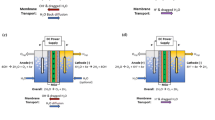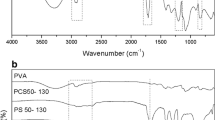Abstract
In the present research, for the first time, lycopodium as a novel nanofiller was incorporated into a polyvinylidene fluoride matrix to fabricate lycopodium/polyvinylidene fluoride flat-sheet membrane for desalination applications by vacuum membrane distillation process. The prepared lycopodium/polyvinylidene fluoride membranes and lycopodium were characterized by field emission scanning electron microscopy, X-ray diffraction, Fourier transform infrared, energy dispersive X-ray, and mapping analyses. Water contact angle and liquid entry pressure measurements were also performed. Response surface methodology was applied to optimize membrane structure and performance. The optimized lycopodium/ polyvinylidene fluoride membrane exhibits superior performance compared to the neat polyvinylidene fluoride membrane in terms of flux, salt rejection, water contact angle, and hydrophobicity. In vacuum membrane distillation experiments, using a 15000 ppm NaCl solution as a feed at 70 °C, the neat polyvinylidene fluoride membrane, optimum membrane, and agglomerated membrane (with high lycopodium loading) demonstrated 3.80, 25.20, and 14.83 LMH flux and 63.30%, 99.99%, 99.96% salt rejection, respectively. This improvement in flux and salt rejection of the optimized membrane was related to the presence of lycopodium with hydrophobic nature and interconnected nano-channels in membrane structure. It was found that lycopodium, as the most hydrophobic material, effectively influences the membrane performance and structure for membrane distillation applications.

Similar content being viewed by others
References
Tijing L D, Choi J S, Lee S, Kim S H, Shon H K. Recent progress of membrane distillation using electrospun nanofibrous membrane. Journal of Membrane Science, 2014, 453: 435–462
Qasim M, Samad I U, Darwish N A, Hilal N. Comprehensive review of membrane design and synthesis for membrane distillation. Desalination, 2021, 518: 115168–115233
Susanto H. Towards practical implementations of membrane distillation. Chemical Engineering and Processing, 2011, 50(2): 139–150
Baker R W. Membrane Technology and Applications. New Jersey: John Wiley & Sons, Ltd., 2012
Capizzano S, Frappa M, Macedonio F, Drioli E. A review on membrane distillation in process engineering: design and energy equations, materials and wetting problems. Frontiers of Chemical Science and Engineering, 2022, 16(5): 592–613
Leaper S, Abdel-Karim A, Gorgojo P. The use of carbon nanomaterials in membrane distillation membranes: a review. Frontiers of Chemical Science and Engineering, 2021, 15(4): 755–774
Jiang X, Tuo L, Lu D, Hou B, Chen W, He G. Progress in membrane distillation crystallization: process models, crystallization control and innovative applications. Frontiers of Chemical Science and Engineering, 2017, 11(4): 647–662
Deng L, Li P, Liu K, Wang X, Hsiao B S. Robust superhydrophobic dual layer nanofibrous composite membranes with a hierarchically structured amorphous polypropylene skin for membrane distillation. Journal of Materials Chemistry A: Materials for Energy and Sustainability, 2019, 7(18): 11282–11297
Purkait M K, Sinha M K, Mondal P, Singh R. Introduction to membranes. Interface Science and Technology, 2018, 25: 1–37
Li H, Shi W, Zeng X, Huang S, Zhang H, Qin X. Improved desalination properties of hydrophobic GO-incorporated PVDF electrospun nanofibrous composites for vacuum membrane distillation. Separation and Purification Technology, 2020, 230: 115889–115902
Zhang J, Ding Q, Xu Q, Xiao T, Yang X. An ultra-robust fabric-embedded PVDF membrane fabricated by NTIPS method and its application for monosodium glutamate concentration in membrane distillation. Journal of Membrane Science, 2021, 635: 119448–119460
Seraj S, Mohammadi T, Tofighy M A. Graphene-based membranes for membrane distillation applications: a review. Journal of Environmental Chemical Engineering, 2022, 10(3): 107974–108007
Murugesan V, Rana D, Matsuura T, Lan C Q. Optimization of nanocomposite membrane for vacuum membrane distillation (VMD) using static and continuous flow cells: effect of nanoparticles and film thickness. Separation and Purification Technology, 2020, 241: 116685–116699
Li Z, Rana D, Wang Z, Matsuura T, Lan C Q. Synergic effects of hydrophilic and hydrophobic nanoparticles on performance of nanocomposite distillation membranes: an experimental and numerical study. Separation and Purification Technology, 2018, 202: 45–58
Li Z, Rana D, Matsuura T, Lan C Q. The performance of polyvinylidene fluoride-polytetrafluoroethylene nanocomposite distillation membranes: an experimental and numerical study. Separation and Purification Technology, 2019, 226: 192–208
Zhou R, Rana D, Matsuura T, Lan C Q. Effects of multi-walled carbon nanotubes (MWCNTs) and integrated MWCNTs/SiO2 nano-additives on PVDF polymeric membranes for vacuum membrane distillation. Separation and Purification Technology, 2019, 217: 154–163
Seraj S, Sheikhi M, Mohammadi T, Tofighy M A. Membrane materials for forward osmosis and membrane distillation in oily wastewater treatment. In: Oil-water Mixtures and Emulsions. American Chemical Society: New York, 2022, 305–346
Wittborn J, Rao K V, El-Ghazaly G, Rowley J R. Nanoscale similarities in the substructure of the exines of fagus pollen grains and lycopodium spores. Annals of Botany, 1998, 82(2): 141–145
Wittborn J, Rao K V, El-Ghazaly G, Rowley J R. Substructure of spore and pollen grain exines in lycopodium, alnus, betula, fagus and rhododendron: investigation with atomic force and scanning tunnelling microscopy. Grana, 1996, 35(4): 185–198
Bidabadi M, Ghashghaei Nejad P, Rasam H, Sadeghi S, Shabani B. Mathematical modeling of non-premixed laminar flow flames fed with biofuel in counter-flow arrangement considering porosity and thermophoresis effects: an asymptotic approach. Energies, 2018, 11(11): 2945–2970
Sang M, Shin J, Kim K, Yu K J. Electronic and thermal properties of graphene and recent advances in graphene based electronics applications. Nanomaterials, 2019, 9(3): 374–407
Rajpoot S, Malik R, Kim Y W. Low thermal conductivity in porous SiC-SiO2-Al2O3-TiO2 ceramics induced by multiphase thermal resistance. Ceramics International, 2021, 47(14): 20161–20168
Zhu W, Zheng G, Cao S, He H. Thermal conductivity of amorphous SiO2 thin film: a molecular dynamics study. Scientific Reports, 2018, 8(1): 1–9
Çimen A, Bilgiç A, Kursunlu A N, Gübbük İ H, Uçan H İ. Adsorptive removal of Co(II), Ni(II), and Cu(II) ions from aqueous media using chemically modified sporopollenin of lycopodium clavatum as novel biosorbent. Desalination and Water Treatment, 2014, 52(25–27): 4837–4847
Kahrizi M, Kasiri N, Mohammadi T, Zhao S. Introducing sorption coefficient through extended UNIQAC and Flory-Huggins models for improved flux prediction in forward osmosis. Chemical Engineering Science, 2019, 198: 33–42
Young T H, Lin D T, Chen L Y, Huang Y H, Chiu W Y. Membranes with a particulate morphology prepared by a dry-wet casting process. Polymer, 1999, 40(19): 5257–5264
Pouya Z A, Tofighy M A, Mohammadi T. Synthesis and characterization of polytetrafluoroethylene/oleic acid-functionalized carbon nanotubes composite membrane for desalination by vacuum membrane distillation. Desalination, 2021, 503: 114931–114944
Khalifa A E, Lawal D U. Performance and optimization of air gap membrane distillation system for water desalination. Arabian Journal for Science and Engineering, 2015, 40(12): 3627–3639
Rakić T, Kasagić-Vujanović I, Jovanović M, Jančić-Stojanović B, Ivanović D. Comparison of full factorial design, central composite design, and Box-Behnken design in chromatographic method development for the determination of fluconazole and its impurities. Analytical Letters, 2014, 47(8): 1334–1347
Simone S, Figoli A, Criscuoli A, Carnevale M C, Rosselli A, Drioli E. Preparation of hollow fiber membranes from PVDF/PVP blends and their application in VMD. Journal of Membrane Science, 2010, 364(1–2): 219–232
Figoli A, Simone S, Criscuoli A, Al-Jlil S A, al Shabouna F S, Al-Romaih H S, Di Nicolò E, Al-Harbi O A, Drioli E. Hollow fibers for seawater desalination from blends of PVDF with different molecular weights: morphology, properties and VMD performance. Polymer, 2014, 55(6): 1296–1306
Drioli E, Ali A, Simone S, Macedonio F, AL-Jlil S A, Al Shabonah F S, Al-Romaih H S, Al-Harbi O, Figoli A, Criscuoli A. Novel PVDF hollow fiber membranes for vacuum and direct contact membrane distillation applications. Separation and Purification Technology, 2013, 115: 27–38
Yadav A, Labhasetwar P K, Shahi V K. Fabrication and optimization of tunable pore size poly(ethylene glycol) modified poly(vinylidene-co-hexafluoropropylene) membranes in vacuum membrane distillation for desalination. Separation and Purification Technology, 2021, 271: 118840–118851
Mokhtar N M, Lau W J, Ng B C, Ismail A F, Veerasamy D. Preparation and characterization of PVDF membranes incorporated with different additives for dyeing solution treatment using membrane distillation. Desalination and Water Treatment, 2015, 56(8): 1999–2012
Ursino C, Ounifi I, di Nicolò E, Cheng X Q, Shao L, Zhang Y, Drioli E, Criscuoli A, Figoli A. Development of non-woven fabric-based ECTFE membranes for direct contact membrane distillation application. Desalination, 2021, 500: 114879–114889
Dyab A K F, Abdallah E M, Ahmed S A, Rabee M M. Fabrication and characterization of novel natural lycopodium clavatum sporopollenin microcapsules loaded in-situ with nano-magnetic humic acid-metal complexes. Journal of Encapsulation and Adsorption Sciences, 2016, 6(4): 109–132
Serzane R, Locs J, Berzina-Cimdina L, Sadretdinovs R. Development of porous ceramics by lycopodium using uniaxial pressing and sintering. Processing and Application of Ceramics, 2010, 4(4): 231–235
Li J, Chen G, Luo S, Pang H, Gao C, Huang S, Liu S, Qin S. Tuning the microstructure of SMA/CPVC membrane for enhanced separation performance by adjusting the coagulation bath temperature. Journal of Applied Polymer Science, 2022, 139(20): 52148–52159
Salem M S, El-Shazly A H, Nady N, Elmarghany M R, Sabry M N. PES/PVDF blend membrane and its composite with graphene nanoplates: preparation, characterization, and water desalination via membrane distillation. Desalination and Water Treatment, 2019, 166: 9–23
Qiu H, Peng Y, Ge L, Villacorta Hernandez B, Zhu Z. Pore channel surface modification for enhancing anti-fouling membrane distillation. Applied Surface Science, 2018, 443: 217–226
Yang Z, Zhang G, Lin L, Ren D, Meng Q, Zhang H. Effects of baffles on separation of aqueous ethanol solution with hollow fibers. Frontiers of Chemical Engineering in China, 2009, 3(1): 68–72
Abdel-Karim A, Leaper S, Faki B, Miguel J, Alled L. Flux-enhanced PVDF mixed matrix membranes incorporating APTS-functionalized graphene oxide for membrane distillation graphene-based membranes for water purification. Journal of Membrane Science, 2018, 559: 309–323
Cassie A B D, Baxter S. Wettability of porous surfaces. Transactions of the Faraday Society, 1944, 40: 546–551
Abdel-Karim A, Luque-Alled J M, Leaper S, Alberto M, Fan X, Vijayaraghavan A, Gad-Allah T A, El-Kalliny A S, Szekely G, Ahmed S I A, Holmes S M, Gorgojo P. PVDF membranes containing reduced graphene oxide: effect of degree of reduction on membrane distillation performance. Desalination, 2019, 452: 196–207
Cheng D, Zhang J, Li N, Ng D R, Gray S, Xie Z. Antiwettability and performance stability of a composite hydrophobic/hydrophilic dual-layer membrane in wastewater treatment by membrane distillation. Industrial & Engineering Chemistry Research, 2018, 57(28): 9313–9322
Mokhtar N M, Lau W J, Ismail A F. The potential of membrane distillation in recovering water from hot dyeing solution. Journal of Water Process Engineering, 2014, 2: 71–78
Zhang Y, Shen F, Cao W, Wan Y. Hydrophilic/hydrophobic janus membranes with a dual-function surface coating for rapid and robust membrane distillation desalination. Desalination, 2020, 491:114561–114571
Tang N, Feng C, Han H, Hua X, Zhang L, Xiang J, Cheng P, Du W, Wang X. High permeation flux polypropylene/ethylene vinyl acetate co-blending membranes via thermally induced phase separation for vacuum membrane distillation desalination. Desalination, 2016, 394: 44–55
Huang C Y, Ko C C, Chen L H, Huang C T, Tung K L, Liao Y C. A simple coating method to prepare superhydrophobic layers on ceramic alumina for vacuum membrane distillation. Separation and Purification Technology, 2018, 198: 79–86
Chen H, Wu C, Jia Y, Wang X, Lu X. Comparison of three membrane distillation configurations and seawater desalination by vacuum membrane distillation. Desalination and Water Treatment, 2011, 28(1–3): 321–327
Acknowledgements
Authors would like to thank Iran National Science Foundation (INSF) for supporting this study (Grant No. 96008182).
Author information
Authors and Affiliations
Corresponding authors
Electronic supplementary material
11705_2022_2276_MOESM1_ESM.pdf
Incorporation of 3-dimensional lycopodium with hydrophobic nature and interconnected nano-channels into polyvinylidene fluoride membranes for desalination applications by vacuum membrane distillation
Rights and permissions
About this article
Cite this article
Seraj, S., Mohammadi, T. & Tofighy, M.A. Incorporation of 3-dimensional lycopodium with hydrophobic nature and interconnected nano-channels into polyvinylidene fluoride membranes for desalination applications by vacuum membrane distillation. Front. Chem. Sci. Eng. 17, 1162–1182 (2023). https://doi.org/10.1007/s11705-022-2276-6
Received:
Accepted:
Published:
Issue Date:
DOI: https://doi.org/10.1007/s11705-022-2276-6




